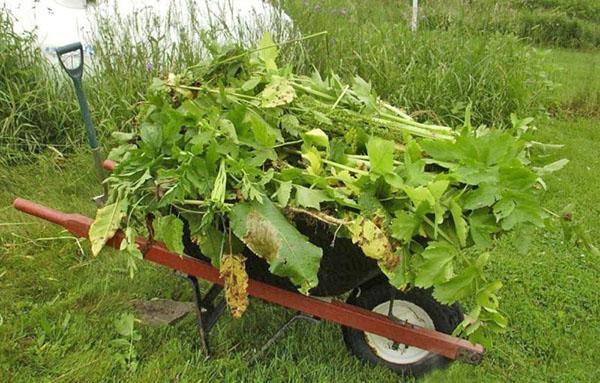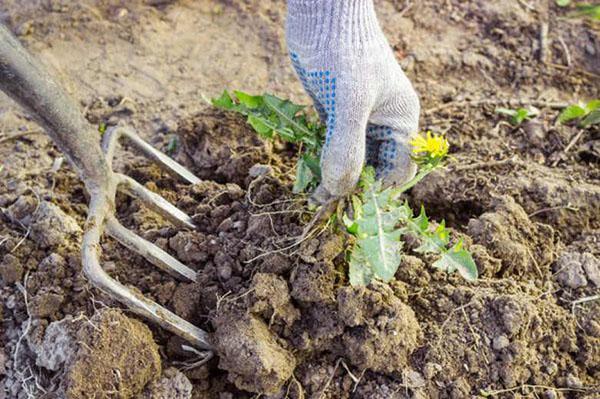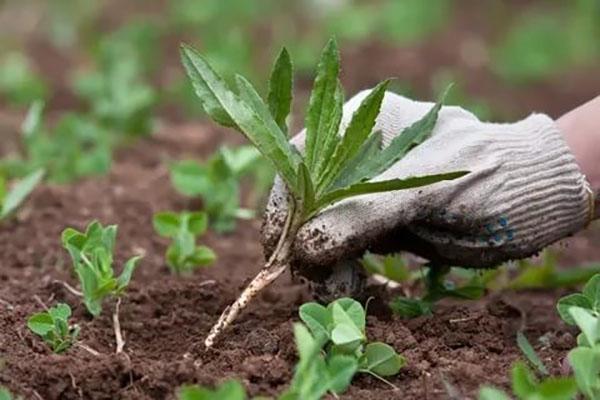Common weeds in the garden and man - the eternal duel of all generations
 Weeds have become a real curse for the human race, with which gardeners vigilantly fight in each new season for 6,000 years. Knowing all the common weeds in the garden, as well as their features, farmers will be able to successfully cope with them. There are several varieties of these malignant plants. They differ in the place of growth, the structure of the root system, as well as botanical characteristics. You can win this eternal duel only if you know your enemies by sight.
Weeds have become a real curse for the human race, with which gardeners vigilantly fight in each new season for 6,000 years. Knowing all the common weeds in the garden, as well as their features, farmers will be able to successfully cope with them. There are several varieties of these malignant plants. They differ in the place of growth, the structure of the root system, as well as botanical characteristics. You can win this eternal duel only if you know your enemies by sight.

Common weeds in the garden: an original collection with names and photos

The sad reality suggests that it is almost impossible to put an end to such "visitors" of a summer cottage once and for all. They sprout and appear in the beds over and over again for 4 reasons:
- fall into the ground along with organic fertilizers, especially when compost not properly processed;

- some varieties of weeds always "live" in the ground and are in a drowsy state, waiting for favorable conditions for active growth;
- transferred to the site with the help of winds, people, as well as animals;

- end up in the garden through contaminated seed.
Both farmers and agricultural crops feel the harm from them. In addition to reducing yields, these plants release harmful substances into the soil, while simultaneously absorbing micronutrients and water. This leads to significant starvation of neighboring crops. Many of the most common weeds are breeding grounds for pathogens and other pests. They are also one of the main causes of poisoning in livestock. Therefore, it is worth getting to know your "rivals" better and determining which weed is the most vicious.
Moreover, the tropical jungle overgrown in the beds significantly spoils the landscape design of the personal plot. In addition, they create a dense shade for all other plants.
Bindweed, oxalis, veronica, sow thistle and runny - dangerously beautiful
Pests feel great in the beds, which are regularly loosened and fed. Therefore, many beautiful weeds grow strong. Nevertheless, at their summer cottage, they look unusually attractive, even charming. These include several popular varieties.
Field bindweed - destructive beauty
 Often this weed creeping on the ground is called a birch. Its stems reach 180 cm in length and are able to grow rapidly, covering up to 2 m² of crops. The roots penetrate 4-5 meters deep into the ground. However, when the bindweed begins to bloom with snow-white or pale pink thunderphones, it pleases the eye.
Often this weed creeping on the ground is called a birch. Its stems reach 180 cm in length and are able to grow rapidly, covering up to 2 m² of crops. The roots penetrate 4-5 meters deep into the ground. However, when the bindweed begins to bloom with snow-white or pale pink thunderphones, it pleases the eye.  However, it's important to remember that creeping weeds are plants that drain the land. They instantly draw nutrients from it, as well as moisture. Therefore, it is worth fighting them at the earliest stages.
However, it's important to remember that creeping weeds are plants that drain the land. They instantly draw nutrients from it, as well as moisture. Therefore, it is worth fighting them at the earliest stages.
To get rid of the bindweed, many have to completely dig out its rhizome. Experts also recommend using herbicides.
Oxalis - useful, but harmful
 The plant owes its name to a pleasant sour taste. Availability in the composition sour (the photo of the weed is attached above) the alkaline and ascorbic acids make it a drug. It is used in the treatment of cardiovascular diseases, as well as to restore digestion.
The plant owes its name to a pleasant sour taste. Availability in the composition sour (the photo of the weed is attached above) the alkaline and ascorbic acids make it a drug. It is used in the treatment of cardiovascular diseases, as well as to restore digestion.
You can recognize this weeds in the garden by the following signs:
- refined three- or five-lobed leaves of a light green shade, similar to clover;
- pale pink or yellow flowers, shaped like bells;
- seed pods that spread seeds over long distances.
Kislitsa loves soil that is free of lime. Therefore, an excellent solution to the problem would be the introduction of quicklime before winter. Raw materials are simply scattered over the beds in small quantities. At the same time, after planting crops, the site is mulched. This layer of dried grass inhibits the growth of the most common weeds in the garden, including sour.
Dosage of lime for different types of soil. Sandy loam - 100-150 g / m², loam - 0.5-1 kg / m². This procedure increases the alkalinity of the earth for the next 2 years.
Veronica - Miniature Pansies
 The peculiarity of this field plant is its incredible vitality and vigor. Its thin and fragile shoots break very easily, which allows them to quickly take root in a new place. It is impossible to completely get rid of these pale blue or cornflower-blue flowers in the garden. Although in the photo the weed Veronica seduces with its magnificence, it is still necessary to remove them from the garden. For this, in the spring, a young plant is treated with herbicides. Do this before the flower buds are tied. It is at this moment that it is most vulnerable.
The peculiarity of this field plant is its incredible vitality and vigor. Its thin and fragile shoots break very easily, which allows them to quickly take root in a new place. It is impossible to completely get rid of these pale blue or cornflower-blue flowers in the garden. Although in the photo the weed Veronica seduces with its magnificence, it is still necessary to remove them from the garden. For this, in the spring, a young plant is treated with herbicides. Do this before the flower buds are tied. It is at this moment that it is most vulnerable.
Veronica filamentous is successfully used in landscape design. It is recommended to plant it in a flower bed with forget-me-nots, since they bloom at the same time.
Sow thistle - a malicious thorn
 The original weed with yellow flowers can grow up to 2 m. Its dense stems are decorated with triangular toothed leaves. Thanks to its powerful root system, the plant grows rapidly both in breadth and in depth. Therefore, simply pulling him out of the ground is not enough, because he is too tenacious.
The original weed with yellow flowers can grow up to 2 m. Its dense stems are decorated with triangular toothed leaves. Thanks to its powerful root system, the plant grows rapidly both in breadth and in depth. Therefore, simply pulling him out of the ground is not enough, because he is too tenacious.
To destroy sow thistle you need:
- weed the garden every 2 weeks, preventing the plant from blooming or growing;
- sprinkle the sow thistle weed (photo above) with soda, salt (1.5 kg per m²) or an essence of vinegar and salt, which is used to treat the rhizome;
- apply chemicals - herbicides;
- digging the site with a pitchfork;
- landing siderates - mustard, legumes and others.
Sow thistle is a thorny weed, so it is important to be careful when removing it. The lateral horizontal processes lie in the ground at a depth of 12 cm and grow up to 1 m wide, and the main taproot up to 50 cm.
 At the same time, it is important to remember that the sow thistle is a dandelion-like weed. However, thorny leaves and elongated stems will prevent the gardener from confusing them. When carrying out planting work, it is important to remove young cobs or roots of weeds. Treatments with harsh drugs are planned for sunny weather, because rain can wash away chemicals and harm other crops.
At the same time, it is important to remember that the sow thistle is a dandelion-like weed. However, thorny leaves and elongated stems will prevent the gardener from confusing them. When carrying out planting work, it is important to remove young cobs or roots of weeds. Treatments with harsh drugs are planned for sunny weather, because rain can wash away chemicals and harm other crops.
Dream or wedding planner
 This perennial plant belongs to tall weeds, since it grows up to 1 m. In the root part of the erect stem, there are leaves collected in fans and growing on long petioles. Deciduous plates often grow up to 30 cm in length and 15-35 cm in width.For this reason, the weed to moan (the photo clearly demonstrates this) often obscures neighboring crops that grow much more slowly.
This perennial plant belongs to tall weeds, since it grows up to 1 m. In the root part of the erect stem, there are leaves collected in fans and growing on long petioles. Deciduous plates often grow up to 30 cm in length and 15-35 cm in width.For this reason, the weed to moan (the photo clearly demonstrates this) often obscures neighboring crops that grow much more slowly.
You can fight such a beautiful crop pest with simple methods:
- remove it before flowering;
- choose a rhizome during autumn or spring digging of a site;
- mulch the planting: mow the weeds and cover the ground with hay / straw, and a week later - with cardboard;
- chemical preparations: "Tornado", "Roundup" or "Glyfosad".
The white-spotted root system (photo below) penetrates 40 cm deep into the soil.Thanks to this, it can grow in one place for about 50 years.
This plant begins to bloom in July. Snow-white umbrellas appear on the tall branches, resembling a bridal bouquet. Although the inflorescences are very beautiful, the weed brings a lot of trouble to the farmer. Still, there are more malicious pests in the collection of weeds.
Dangerous loach weeds - pig and wheatgrass
 These weed varieties have an unusually strong and creeping root system. Any damage to the roots leads to the appearance of young shoots, which serves as an excellent way of their reproduction. Therefore, weeds with long roots must be removed from the garden correctly and on time.
These weed varieties have an unusually strong and creeping root system. Any damage to the roots leads to the appearance of young shoots, which serves as an excellent way of their reproduction. Therefore, weeds with long roots must be removed from the garden correctly and on time.
In the solid ground, they are at a depth of 18 cm, and in the dug up ground - 25 cm.
The pig cannot be destroyed
 This drought-resistant and thermophilic plant calmly tolerates summer heat and even drought. Surprisingly hardy, the grass grows in all types of soil, but prefers well-lit areas of land. It often clogs:
This drought-resistant and thermophilic plant calmly tolerates summer heat and even drought. Surprisingly hardy, the grass grows in all types of soil, but prefers well-lit areas of land. It often clogs:
- vineyards;
- lawns;
- plantations of cotton;
- flower beds with perennial grasses.
 To understand how to remove it from the garden, you need to consider the botanical features. Looking at the photo of the pig weed, you can see that the aerial shoots are rooting with the help of nodes. This happens when young stems grow on the surface and then begin to grow to the ground. The rhizomes of the plant are thick and with large scaly formations. In the ground, they are located horizontally or under a certain slope.
To understand how to remove it from the garden, you need to consider the botanical features. Looking at the photo of the pig weed, you can see that the aerial shoots are rooting with the help of nodes. This happens when young stems grow on the surface and then begin to grow to the ground. The rhizomes of the plant are thick and with large scaly formations. In the ground, they are located horizontally or under a certain slope.
You can remove the pig from the garden by deep plowing. After harvesting, the soil is dug up, allowed to dry, and then the filamentous roots are carefully selected. In those places where there is a lot of it, it is recommended to sow cereals.
Wheatgrass is an immortal weed
 This holly grass is familiar to every gardener. Due to its knobby and creeping roots, it has become almost invincible. Its root system is located in the upper soil layers - 5-6 cm and spreads over the surface, occupying an area of several square meters. However, in loose soil, the rhizome penetrates to a depth of 15-20 cm, but not deeper.
This holly grass is familiar to every gardener. Due to its knobby and creeping roots, it has become almost invincible. Its root system is located in the upper soil layers - 5-6 cm and spreads over the surface, occupying an area of several square meters. However, in loose soil, the rhizome penetrates to a depth of 15-20 cm, but not deeper.
 A few photos of gray wheatgrass will help the gardener remember it. When weeding a garden bed, the farmer should know that each root of this weeds must be selected from the site. At the same time, the introduction of the three-field crop rotation technique will help to forget about it for a long time.
A few photos of gray wheatgrass will help the gardener remember it. When weeding a garden bed, the farmer should know that each root of this weeds must be selected from the site. At the same time, the introduction of the three-field crop rotation technique will help to forget about it for a long time.
One of the effective methods of control is the use of chemical preparations, which include cletodim. The dosage for such herbicides is: liter per 1 ha. Also, agents based on setoccidin are used, but they are applied at 3 l / ha.
Here are just some of the photos and names of weed loaches that give summer residents a headache. There are many more of them in each separate region. However, there is another amazing category of weeds.
Cereals prototypes - wild oats, chicken millet and gumay

In appearance, they can be confused with cereals, but knowing their botanical characteristics, such a mistake can be avoided. Here are just a few popular pest cereals:
- Weed gumay. The photo shows that this herbaceous plant is very high - up to 1.5-2 m. The main powerful root deepens into the ground by 50 cm, and the adventitious branches - up to 200 cm. Gumay germinates at a temperature of 10-12˚С. The flowering and fruiting period is from May to August.

- Wild oat grass. In the photo you can see that the plant resembles ordinary oats. Its fibrous root system penetrates 150 cm deep into the soil if allowed to germinate. But the stem rises above the ground to a height of 60-120 cm and is crowned with fluffy ears. In the company with him, the yield of crops drops by 3 times, and the soil is depleted.

- Chicken millet weed.Seeing his photo, many recognize him as a barnyard (popular name). It can often be found in carrots, sunflowers and beets. With heavy rainfall, it drowns out early crops.

Young shoots of gumai contain a poisonous substance that causes indigestion in livestock. Only a properly thought out crop rotation can cope with it. For example, alfalfa sowing inhibits the life of the plant.
 Another cereal weed is the herb bison or champion, from which alcoholic drinks, infusions and cocktails are made. Its erect, ascending stem reaches 70 cm in height. The root system is distinguished by long, creeping processes. Flat, elongated leaves at the base stand out with a slight white tint. It should be dealt with in the same way as with other common weeds in the garden, which have elongated roots. The best way to do this would be herbicides, as well as removing the rhizomes mechanically.
Another cereal weed is the herb bison or champion, from which alcoholic drinks, infusions and cocktails are made. Its erect, ascending stem reaches 70 cm in height. The root system is distinguished by long, creeping processes. Flat, elongated leaves at the base stand out with a slight white tint. It should be dealt with in the same way as with other common weeds in the garden, which have elongated roots. The best way to do this would be herbicides, as well as removing the rhizomes mechanically.